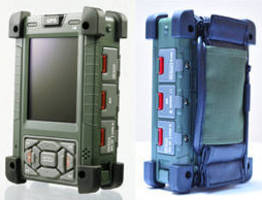PCs Built for the Apocalypse
Let’s say you run an industrial kitchen, or a level-4 biohazard lab, or you’re on the run from a zombie apocalypse. You need a PC that is as indestructible as a block of granite. It might sit out in the sun all day long, or be hosed down with harsh chemicals. Then, after civilization collapses, it’ll need to survive a bad fall as you head into the Rockies where you hope to escape your undead pursuers.

It’s not a product category most of us think about, because we’re so used to iPhones that can barely be let out of their cases and laptops whose fans growl to life whenever the temperature in the room gets above 80 degrees.
But isn’t it time we graduated from all this mollycoddling? Thirty-five years with the PC, and we still have to treat these things like they’re priceless china? How’s that going to work out for you when you’re on the lam in deepest Appalachia?
In the spirit of indoor/outdoor furniture, the general ruggedization of everything in sight and, of course, the end of the world, it’s time we met the beefed-up answer to the trend of metrosexualization in the PC industry (think tablets, netbooks and smartbooks): the Panel PC.
Just announced by American Industrial Systems, the Panel PC looks every bit as unapologetically utilitarian as its name implies: it’s enclosed in an all-stainless steel case with no buttons or outlets (besides sealed I/O ports) into which moisture or grit can find its way.
Its 4X National Electrical Manufacturers rating indicates that it’s “designed for indoor or outdoor use […] and protects the enclosed equipment from falling dirt, rain, sleet, snow, windblown dust, splashing water, hose-direct water, and corrosion. These enclosures are undamaged by the external formation of ice.”
The Panel PC uses a low-power Intel Atom chip, so it has no fan, and an optional transflective display so that you can view it in full sunlight. It start at $2,000, but what do you expect from a tablet computer that advertises itself as highly resistant to powerful acids?

Other devices in this category are include the iPad-like Mobile Data Terminal PC, which “meets military standards.” Disappointingly, that means it’s proof against falls, not bullets.

And for those of you who have paid for the replacement of a cracked iPhone screen for the last time, there’s always the 3G-capable Ultra Rugged Mobile PDA, which is insulated against electromagnetic interference, vibration, drops, freezing cold, baking sun and immersion in water up to a depth of one meter.
All kidding aside, devices like this raise an important question: why aren’t our electronics more durable? The benefits of more rugged (versus prettier) industrial design include eco-friendliness, reduced total cost of ownership, and general relief from the headaches of planned obsolescence.
Unless locking us into a hedonic treadmill of new device acquisition is exactly what the consumer electronics industry is all about…
![]() Follow Christopher Mims on Twitter, or contact him via email.
Follow Christopher Mims on Twitter, or contact him via email.
Keep Reading
Most Popular
Large language models can do jaw-dropping things. But nobody knows exactly why.
And that's a problem. Figuring it out is one of the biggest scientific puzzles of our time and a crucial step towards controlling more powerful future models.
The problem with plug-in hybrids? Their drivers.
Plug-in hybrids are often sold as a transition to EVs, but new data from Europe shows we’re still underestimating the emissions they produce.
Google DeepMind’s new generative model makes Super Mario–like games from scratch
Genie learns how to control games by watching hours and hours of video. It could help train next-gen robots too.
How scientists traced a mysterious covid case back to six toilets
When wastewater surveillance turns into a hunt for a single infected individual, the ethics get tricky.
Stay connected
Get the latest updates from
MIT Technology Review
Discover special offers, top stories, upcoming events, and more.